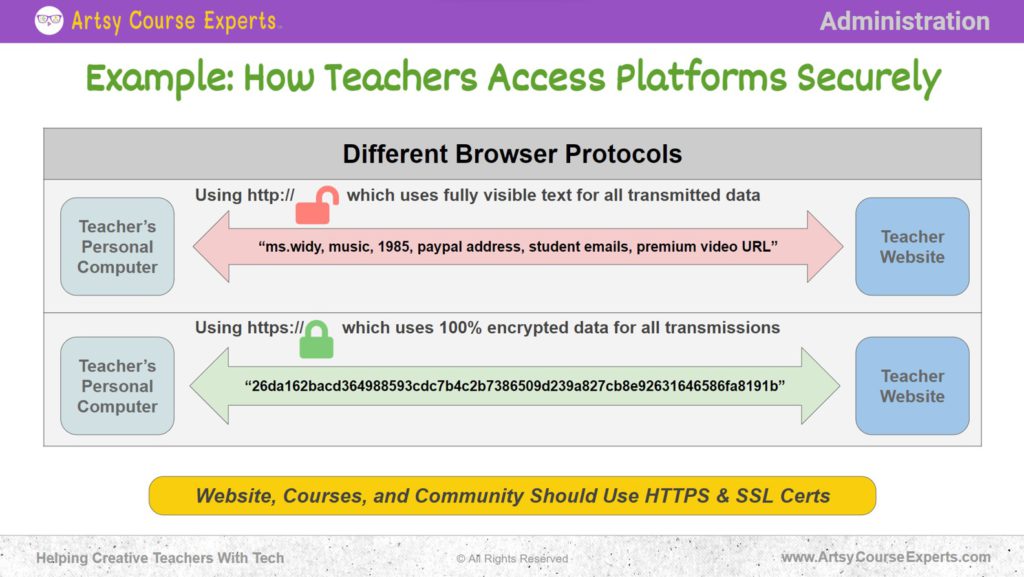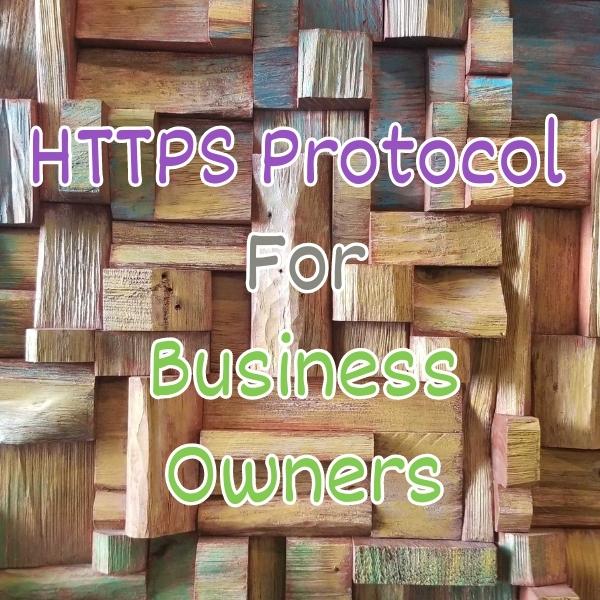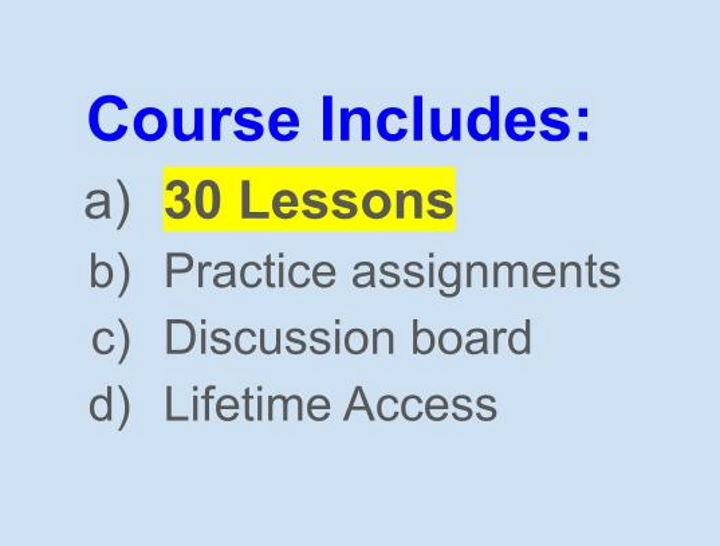Introduction
If you own a business and want to safeguard your finances, content, and customers base, then understanding HTTPS is crucial. While you manage your business and craft captivating content for your audience, ensuring a secure online environment becomes paramount.
In this lesson, we are delving into the HTTPS protocol for creative business owners. This knowledge will empower you to navigate your business operations securely and create a safe platform for customers to conduct transactions. We will cover HTTPS for creative business owners—what it is, why use it, how to use it, and then we will provide an example and recap.
Challenges online course creators can face if they don’t use HTTPS for their online content:
- In the absence of HTTPS, sensitive customer information is exposed, leading to potential data breaches.
- Websites that lack HTTPS receive lower rankings in search results, adversely impacting online visibility and reach.
- Absence of encryption exposes valuable course content to unauthorized access and piracy threats.
- Data breaches can lead to legal repercussions, causing financial and reputational harm to course creators.
- Lack of HTTPS erodes customer confidence, deterring them from making purchases or sharing personal information.
Video Lesson – How To Safeguard Sensitive Data, Build Customer Trust, and Improve Search Engine Visibility
Who Can Use HTTPS?
Virtually any type of educator, professional, or coach can employ HTTPS to ensure the secure transmission of proprietary files and protect valuable intellectual property.
- Establishing a secure environment for students to access tutorial videos and instructional materials.
- To secure the exchange of confidential fashion sketches, sewing patterns, and personal information shared.
- Ensuring the protection of sensitive customer data and payment information through the utilization of HTTPS.
This can be adapted by diverse array of educational businesses including woodworking, pattern designing, and cartoonist ventures.
What Is It?
HTTPS is a protocol—a way that two computers communicate, resembling a language. For example, your web browser talks to a web server, and they understand each other. The web browser might request the HTML for your webpage, and the server responds correspondingly. HTTPS ensures a secure avenue to access web based information, guaranteeing the safety of customer transactions.
Underneath, there is an earlier version called HTTP, lacking security measures. When you use HTTP to fetch something from the web, whatever you type is sent over the wire, and anyone with access to your router or Wi-Fi can see everything you type to the server and whatever comes back from the server. However, HTTPS, with the ‘S’ denoting security; employs encryption to safeguard all communication.
Why Use HTTPS?
Unfortunately, the world is becoming more dangerous, especially when using public Wi-Fi at cafes or airports. Someone in the middle could potentially log all your input and output. When you use HTTPS, you create a secure tunnel between you and the server, and no one else can see the messages going back and forth. HTTPS secures all your messages.
If you don’t use HTTPS, when accessing your website, bank, media server, courses, community, or any other services, all your data remains vulnerable during transmission. This scenario resembles a bridge where passing cars unveil passwords, usernames, and customer emails.
When your customers access your coaching services, courses, or community without HTTPS, their credit card information becomes equally exposed, just like watching transactions on a bridge.

How To Guide
Now, let’s go over how to use HTTPS for your business. This not only benefits you as the business owner but also ensures your customers’ security for all the services you offer.
HTTPS Is a Secure Communications Protocol between Devices
HTTPS is a secure communication protocol—an arrangement of rules on how things interact. When you request something, it will be encrypted, sent, and decrypted upon receipt.
SSL (Older) & TLS (Newer) Are the Encryption / Decryption Algorithms
You may be familiar with SSL, which stands for Secure Sockets Layer, although there is a newer encryption algorithm called TLS. HTTPS serves as a framework arrangement on how two computers communicate, while SSL (or TLS) is the encryption algorithm, involving various mathematical operations to ensure data security.
Certificate (Files) Are Used to Encrypt and Authenticate a Domain
To make all this work, you need a certificate file. When you possess a domain, such as company.com from GoDaddy, you can install a certificate. This certificate file consists of random numbers and acts as a unique certificate for all encryption and decryption activities. The certificate file is connected to your website domain.
Use for Customer Transactions, Email, Web, Banking, Remote Work
Remember, the HTTPS protocol is essential for you as the business owner to protect your money, intellectual property, and all your content. Moreover it’s great for your customers too.
As customers make transactions and share personal information while receiving assets, all of that is secure. Customers want to be assured that their credit card information and inquiries directed towards a coach remain confidential.
Customers Have Been Trained to Look for Little Lock Icon on Browser
Over the years, we’ve all been trained to look for the little lock icon on our web browsers. That signal reassures customers that their transactions are safe. When you see that lock icon and if you look to the left of the web address, you’ll notice that the address starts with HTTPS instead of HTTP.
Remember Google SEO Algorithms Rank HTTPS Higher Over HTTP
Google now ranks websites that use HTTPS higher. It’s sort of a preferred status, and they get a bonus. So, in a scenario with two similar websites, offering musical instrument courses, the distinction lies with one site being HTTPS- enabled and works really well on mobile. These two minor advantages will make one website rank higher than the other.
Google has made it official that security is important for ranking services, whether it’s a website, a community, or courses. By adopting HTTPS, you potentially rank higher than other services out there.
Websites Often Redirect All Pages Like HTTP to HTTPS
As an administrator, or with the help of your tech person, whenever a customer or a prospect accesses your website using the non-encrypted HTTP, you can redirect them to the secure version. Maybe they clicked on some link in social media and landed on the HTTP version, so you can configure the properties to redirect them to the HTTPS version for enhanced security during transactions and logins.
Check and Monitor Your Certificates for Expiration
Remember, all these work because you have a certificate file registered for your website. Your website has a certificate, and that certificate plays a vital role all the encryption and decryption processes. But that certificate may potentially expire every few months or every year.
Therefore, you need to keep an eye on it to prevent visitors from bouncing and leaving your website due to browser warnings.

Example: How Teachers Access Platforms Securely
In this example, let’s go over how a creative professional teacher is going to access their platform. They will initiate the process by entering their login credentials and navigating through their administration portal. This will involve tasks reviewing statistics, checking students’ transactions, and accessing their premium content.
The Teacher Is Using an Unsecure HTTP
In this case, the teacher is at home using their personal computer to log into platform. However, this approach lacks security as it relies on the use of HTTP. So they input their username and password, scroll through student emails, check new customers, and access premium video content, all these activities are susceptible. They might download or upload new content that they don’t want to give away; intending to restrict access through a paywall.
Unfortunately, when all of this is happening on a browser with HTTP, this all becomes visible if the teacher is connected to Wi-Fi at a café or airport someone. Someone could be logging all the data packets that go back and forth between the teacher and server. The username and password could be vulnerable since it’s not encrypted. it’s just what you type in a package that goes over the internet and Wi-Fi and that’s very risky.
The Teacher Is Using a Secure HTTPS
On the other hand if the teacher at a café or airport and is using HTTPS, they employ a secure protocol. Every piece of information to and from the platform is encrypted. Even if an authorized party has access to the packets, they won’t understand anything as each session is encrypted slightly differently, making it gibberish to most people.
Utilization of HTTPS also instills confidence among customers making purchases, as they recognize the platform is secure and trustworthy. The use of HTTPS and SSL or TLS certificates is highly recommended for websites, courses, communities, and webinars.
As you’re building different services, you’re really just building one website, one course system, one community. Remember, HTTP and HTTPS are protocols, determining how you access content, but you’ll build one piece of content. You don’t need to create two separate versions, (one secure and one not secure). Instead, you are basically building one piece of content, and then the browsers, mobile phones, tablets or computers will access the content either using HTTP or HTTPS.
HTTPS use is applicable across a wide spectrum, regardless of whether you’re teaching practical skills, writing skills, performing skills, or audiovisual techniques. Irrespective of the subject matter, HTTPS is a fundamental component of your business ecosystem.
Frequently Asked Questions About Using HTTPS for Creative Business Owners

Summary – HTTPS for Creative Business Owners
HTTPS is a protocol, like a language for communication. SSL and TLS are the encryption algorithms; the math formulas. It protects valuable customer data, enhances credibility, and instills confidence in every interaction. By addressing the challenges associated with data vulnerability, reduced customer trust, and compromised search engine rankings, HTTPS empowers creative entrepreneurs to build a robust and thriving online presence.
Behind the scenes, there’s a certificate with random information, specific to your website, and all three of these work together to ensure secure information on your website, not only for you and your team as administrators but also for your customers.
Tips for creative online course creators when using HTTPS for their online businesses:
- Level up with a small action: Go to your web browser and view the certificate.
- Check for the lock icon on your web page to ensure it’s present.
- Verify if your HTTP automatically converted to HTTPS; if not, investigate further.
- While on HTTPS, ensure the presence of the lock icon, signifying an SSL certificate for enhanced security.
- Implement HTTP Strict Transport Security (HSTS) to further enhance security.
You should be a little smarter now. Thanks for hanging out!
Please subscribe to get more tips for creative online course teachers.
More Tips For Online Teachers
These lessons can also help you with Operations and Technology:
- Analytics for Teacher Websites
- When to Upgrade Your Hosting Plan For Creatives
- RSS Feeds For Online Training Business Owners
- What are HTTP Status Codes And How Browsers Request Information?
- Video Hosting Options For Online Courses











